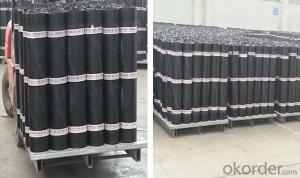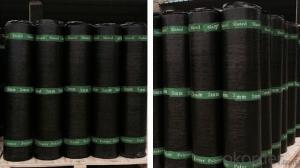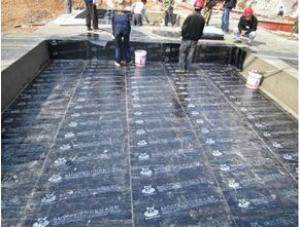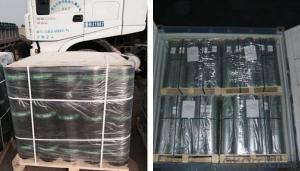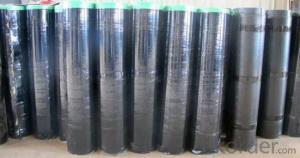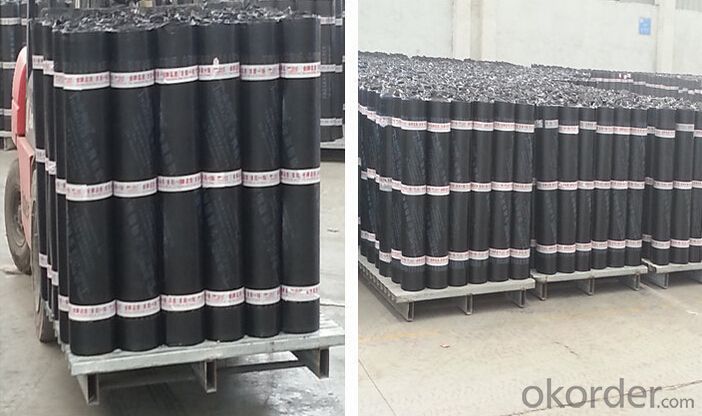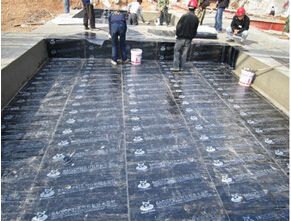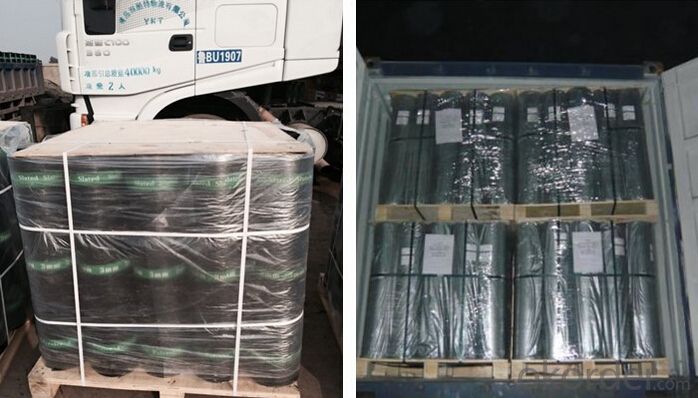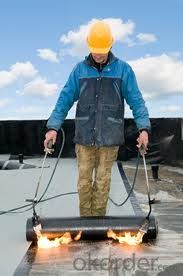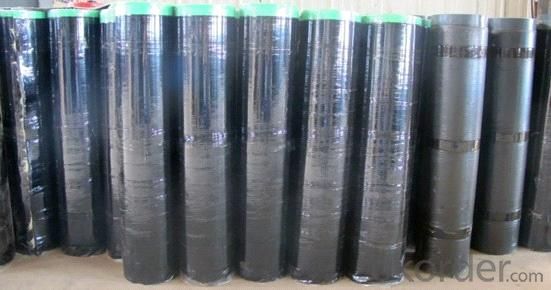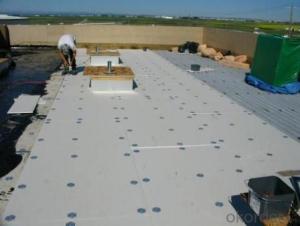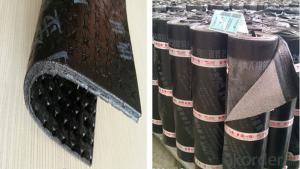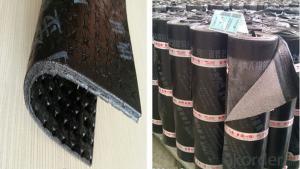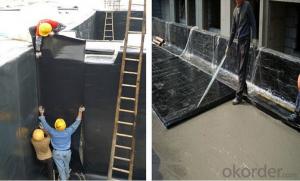SBS Elastomer Modified-bitumen Waterproof Membrane For Roof
- Loading Port:
- Shanghai
- Payment Terms:
- TT OR LC
- Min Order Qty:
- 1000 m²
- Supply Capability:
- 200000 m²/month
OKorder Service Pledge
OKorder Financial Service
You Might Also Like
product description:
SBS Waterproof Membrane using polyester reinforcement for waterproofing is a new type of wateproof material,it's made from polyester felt as its reinforcement featuring high strength,elongation amd corrision resistance, SBS compound as its modifier for meeting the torched-on applications, it shall be covered with polyethylene membrane(PE),aluminium foil, colorful sand or mineral granule on its top surface and polyethylene membrane(PE) coated on its under face. This series of membrane is designed for the waterproofing of underground construction such as tunnel, subway, basement,roofs and pools etc.
Characteristic
Good impermeability
Thinckness: 3mm,4mm,5mm
Length:8m,10m or customed
Being applied in the cold area with low temperature:0°C, -5°C, -10°C,-20°C, -25°C
Good performance in anti-puncture, anti-broker, anti-resistance, anti-erosion, anti-mildew, anti-weathering
Possess good tensile strength, elongation rate and size stability which could be well suited the substrate distortion and crack
Applicable scope:
It is widely used for civil building roofing, underground, bridge, parking, pool, tunnel in the line of waterproofing and dampproofing, especially for the building under high temperature.
Application
The needle-punched polyester is widely used as the carrier for waterproofing membrane production. The membrane made withneedle-punched polyester matis widely used for: Construction waterproofing; Moisture-proof in roof engineering, underground engineering, indoor ground, etc;Corrosion resistance for water pool or building bases.
Our Services
1.If you need some advises for the waterproof construction, we have the best engineer to serve you.
2.We send the free samples to you by freight collect.
3.We will guarantee the quality and the competitive price.
4.We will give you the best packaging and safe shipping.
5.If any problem, we will always be right here waiting for you.
Packaging & Shipping

| Packing | Woven bag/PE bag packing or as customer request |
| Shipping | FOB Changsha,customized shipping terms and oppointed port accepted |
Technical parameter
| Item | Specifications | ||||||||
| Geotextile Unit Weight (g/m²) | 300 | 500 | 600 | 700 | 800 | 900 | 1000 | 1100 | |
| Geomembrane Thickness (mm) | 0.25-0.35 | 0.30-0.50 | |||||||
| Nominal Fracture Strength (KN/m) | 2.50 | 7.50 | 10 | 12 | 14 | 16 | 18 | 20 | |
| Breaking Strength (KN/m,≥,LD/TD) | 2.50 | 7.50 | 10 | 12 | 14 | 16 | 18 | 20 | |
| Standard Intensity Corresponding Elongation Rate (%) | 30~100 | ||||||||
| CBR Burst Strength (KN,≥) | 0.70 | 1.50 | 1.90 | 2.20 | 2.50 | 2.80 | 3.00 | 3.20 | |
| Longitudinal Tear Strength (KN,≥) | 0.05 | 0.25 | 0.32 | 0.40 | 0.48 | 0.56 | 0.62 | 0.70 | |
| Hydrostatic Pressve (Mpa) | See List Below | ||||||||
| Peel Strength (N/cm,≥) | 6 | ||||||||
| Vertical Permeability Coefficient (cm/s) | According to design or contract mentioned. | ||||||||
| Width Variation (%) | -1.00 | ||||||||
| Item | Geomembrane Thickness (mm) | ||||||||
| 0.20 | 0.30 | 0.40 | 0.50 | 0.60 | 0.70 | 0.80 | 1.00 | ||
| Hydrostatic Pressve (Mpa) | One geotextiles with one geomembrane | 0.40 | 0.50 | 0.60 | 0.80 | 1.00 | 1.20 | 1.40 | 1.60 |
| Two geotextiles with one geomembrane | 0.50 | 0.60 | 0.80 | 1.00 | 1.20 | 1.40 | 1.60 | 1.80 | |
Professional test machines ensure the products qualified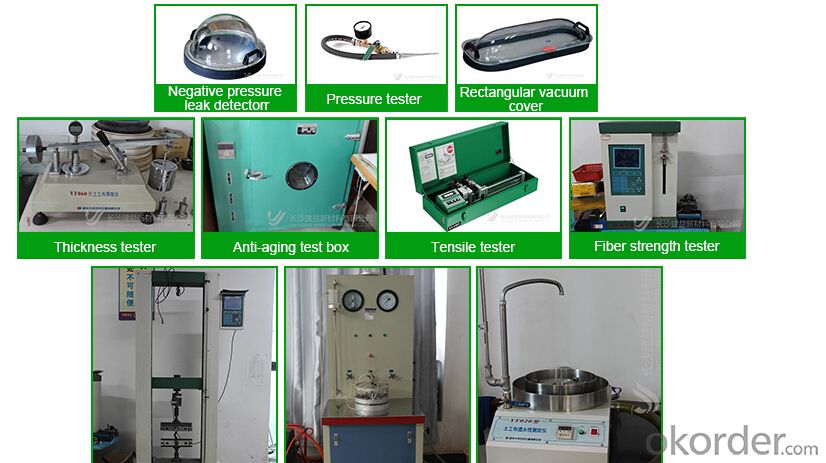 roduct certifications
roduct certifications
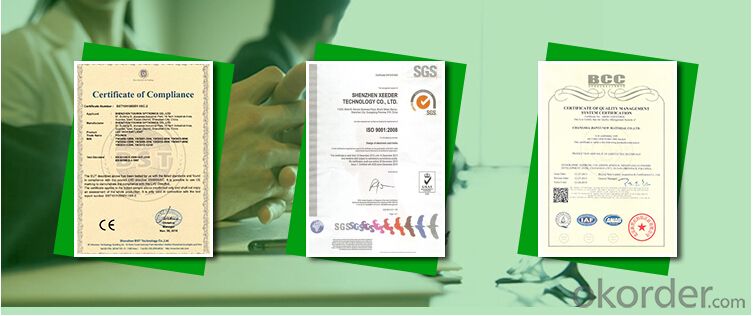
Inquiry Note
How to send an effective inquiry for saving your time?
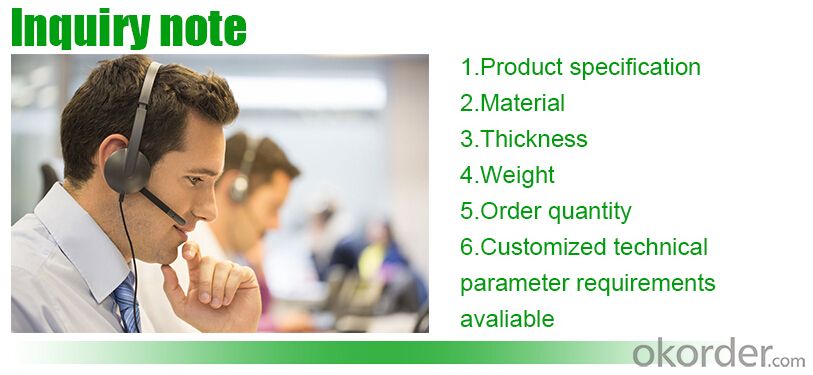
product show

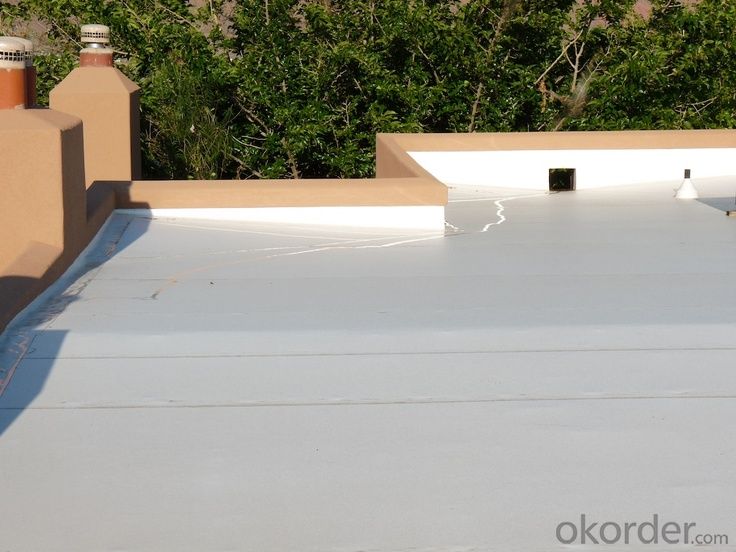

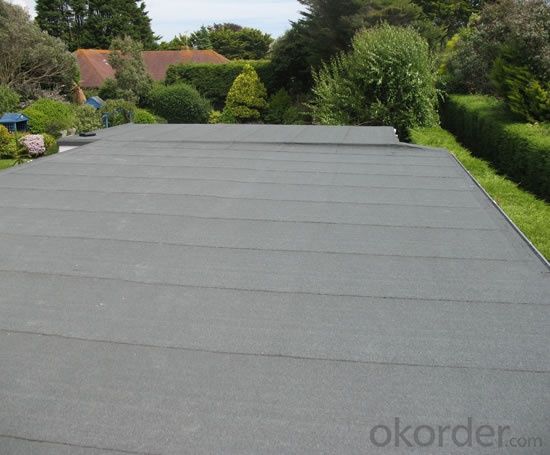
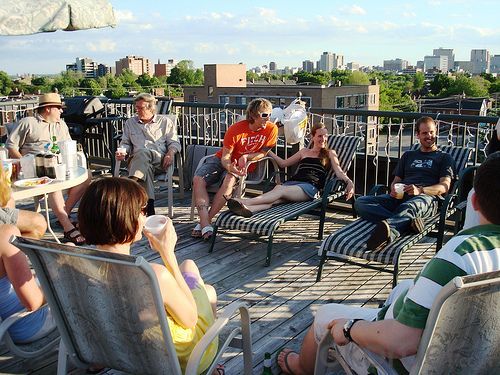
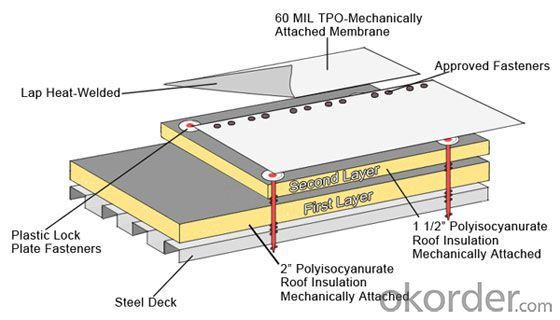
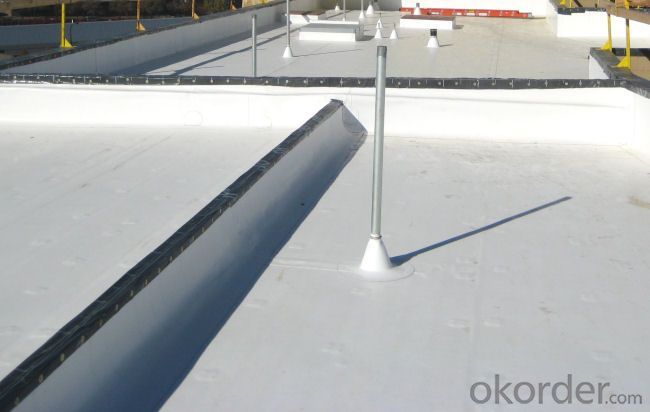
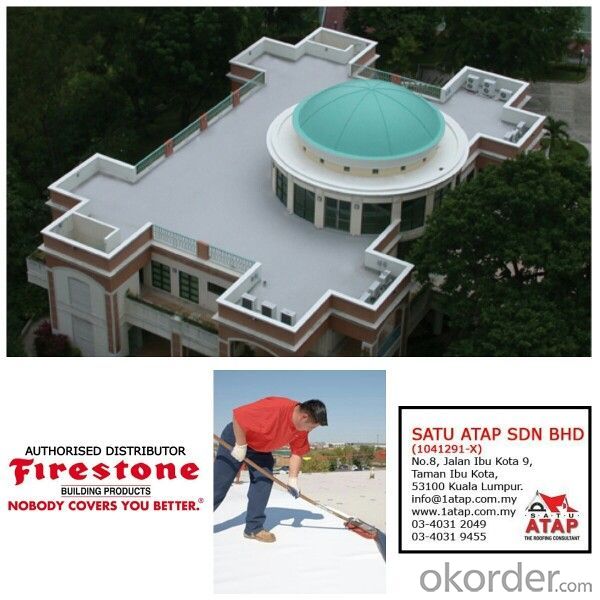
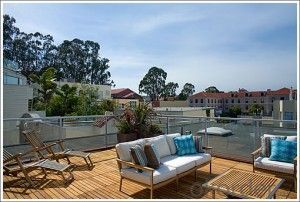
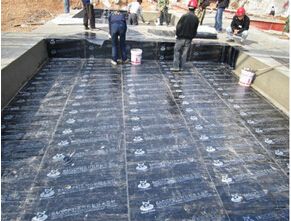
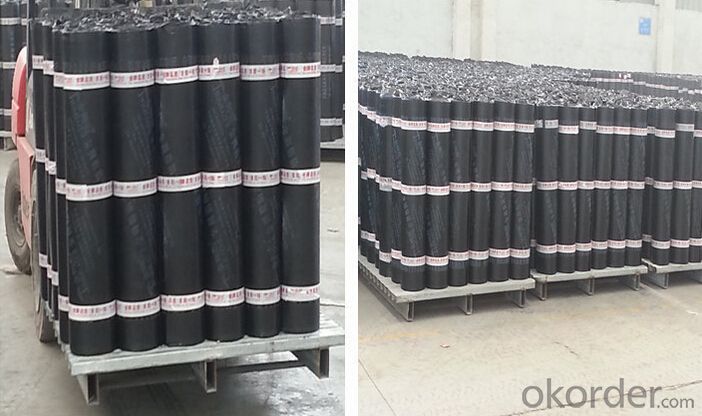

FAQ

- Q: Can a waterproofing membrane be used in government or municipal projects?
- Yes, a waterproofing membrane can be used in government or municipal projects. In fact, it is a common practice to use waterproofing membranes in various infrastructure projects such as bridges, tunnels, parking structures, and government buildings. These membranes provide a reliable and durable solution to prevent water infiltration, protect the structural integrity of the project, and extend its lifespan. Additionally, waterproofing membranes can meet the necessary regulations and standards required for government or municipal projects.
- Q: Can a waterproofing membrane be used for HVAC systems?
- No, a waterproofing membrane cannot be directly used for HVAC systems. Waterproofing membranes are designed to prevent water from penetrating through surfaces such as roofs, foundations, or walls. They are typically made of materials like bitumen, rubber, or polyurethane and are meant to protect against water damage. On the other hand, HVAC (Heating, Ventilation, and Air Conditioning) systems are responsible for regulating temperature, humidity, and air quality within a building. They consist of various components like ductwork, air handlers, and condensing units that are specifically designed for the purpose of conditioning and circulating air. While there may be some overlap in terms of protecting certain HVAC system components from moisture, such as ductwork insulation, a waterproofing membrane alone is not sufficient or appropriate for HVAC systems. HVAC systems require specialized materials and equipment that are designed to handle the specific needs and requirements of air conditioning and ventilation. Therefore, it is important to use the proper materials and equipment specifically designed for HVAC systems to ensure their efficient and effective operation.
- Q: Are waterproofing membranes fire-resistant?
- The fire-resistant properties of waterproofing membranes can differ. Certain membranes are specifically engineered to be fire-resistant, whereas others may lack any fire resistance at all. To ascertain the fire-resistant capabilities of a particular waterproofing membrane, it is crucial to examine its specifications and certifications. Moreover, in specific applications, building codes and regulations might impose mandatory fire resistance requirements for waterproofing membranes.
- Q: Can a waterproofing membrane be used in basements and foundations?
- Yes, a waterproofing membrane can be used in basements and foundations. Waterproofing membranes are specifically designed to prevent the penetration of water and moisture, making them an effective solution for protecting basements and foundations from water damage.
- Q: Can waterproofing membranes be used on green roofs?
- Yes, waterproofing membranes can be used on green roofs. In fact, they are an essential component of green roof systems as they prevent water leakage and protect the underlying structure. Waterproofing membranes are specifically designed to withstand the unique challenges posed by green roofs, such as water infiltration and root penetration, ensuring the longevity and effectiveness of the green roof system.
- Q: Can a waterproofing membrane be used for a foundation wall?
- A foundation wall can indeed utilize a waterproofing membrane. It is highly advisable to employ such a membrane to shield the foundation against water infiltration and moisture-related harm. Typically, this membrane is applied on the outer side of the foundation wall, serving as a barrier to prevent water from penetrating. Its design entails flexibility, durability, and resistance to hydrostatic pressure, thereby ensuring long-lasting protection for the foundation. Moreover, the membrane aids in preventing water from seeping into the basement or crawl space, thereby decreasing the risk of mold, mildew, and structural problems. Ultimately, employing a waterproofing membrane for a foundation wall is an effective means of safeguarding the building's foundation, guaranteeing its integrity and longevity.
- Q: Can a waterproofing membrane be used for plant rooms?
- Indeed, plant rooms can benefit from the utilization of a waterproofing membrane. These rooms frequently accommodate machinery and equipment that necessitate safeguarding against water and moisture. Employing a waterproofing membrane can effectively avert water-related harm to both the plant room and its enclosed equipment. By establishing a protective barrier, the membrane effectively prohibits the infiltration of water into the walls, floors, and ceilings of the plant room. This becomes particularly crucial in regions prone to water leaks or condensation. Waterproofing membranes are meticulously engineered to endure diverse environmental circumstances, guaranteeing enduring protection for plant rooms.
- Q: Can a waterproofing membrane be used in hot climates?
- Yes, a waterproofing membrane can be used in hot climates. The membrane is designed to withstand various weather conditions, including high temperatures, and is effective in preventing water ingress regardless of the climate.
- Q: Can a waterproofing membrane be used in geotechnical applications?
- Yes, a waterproofing membrane can be used in geotechnical applications. It is commonly used to prevent water infiltration in structures such as tunnels, retaining walls, and basements. The membrane acts as a barrier, effectively sealing the structure and protecting it from water damage.
- Q: Can a waterproofing membrane enhance the durability or lifespan of a structure?
- Certainly, the durability and lifespan of a structure can be significantly enhanced with the use of a waterproofing membrane. This type of membrane acts as a protective layer, applied to the exterior of structures like buildings or bridges, with the purpose of preventing water penetration. Essentially, it functions as a barrier that stops water from seeping into the structure and causing harm. Water is a common and destructive element that can negatively impact the longevity of any structure. When water infiltrates a building or any other type of structure, it can lead to a variety of problems, including mold growth, deterioration of building materials, corrosion of metal reinforcements, and even structural instability. However, by implementing a waterproofing membrane, these risks can be significantly reduced or even eliminated altogether. The installation of a waterproofing membrane not only prevents water from entering, but it also safeguards the structure against other environmental factors such as moisture, humidity, and freeze-thaw cycles. Acting as a shield, it ensures that the building materials remain intact and reduces the likelihood of cracks, leaks, and other forms of structural damage. By enhancing a structure's durability, a waterproofing membrane can effectively prolong its lifespan. Considered a long-term investment, it helps prevent costly repairs and maintenance caused by water-related issues. By keeping the structure dry and protected, it adds years or even decades to its lifespan, ultimately saving both time and money in the long run. In conclusion, a waterproofing membrane is an essential component for maintaining the durability and lifespan of any structure. By preventing water infiltration and protecting the building materials from damage, it ensures the longevity of the structure and provides peace of mind to its owners and occupants.
Send your message to us
SBS Elastomer Modified-bitumen Waterproof Membrane For Roof
- Loading Port:
- Shanghai
- Payment Terms:
- TT OR LC
- Min Order Qty:
- 1000 m²
- Supply Capability:
- 200000 m²/month
OKorder Service Pledge
OKorder Financial Service
Similar products
Hot products
Hot Searches
Related keywords
